Intel NUC6CAYH (Arches Canyon) Apollo Lake UCFF PC Review
by Ganesh T S on January 12, 2018 8:00 AM EST- Posted in
- Systems
- Intel
- NUC
- UCFF
- Apollo Lake
- Arches Canyon
Performance Metrics - II
In this section, we mainly look at benchmark modes in programs used on a day-to-day basis, i.e, application performance and not synthetic workloads.
x264 Benchmark
First off, we have some video encoding benchmarks courtesy of x264 HD Benchmark v5.0. This is simply a test of CPU performance. As expected, the Celeron J3455 is at the top in both passes. Recent releases of the x264 benchmark can show even more impressive gains, as they make use of the latest and greatest features of the modern Intel processors.


7-Zip
7-Zip is a very effective and efficient compression program, often beating out OpenCL accelerated commercial programs in benchmarks even while using just the CPU power. 7-Zip has a benchmarking program that provides tons of details regarding the underlying CPU's efficiency. In this subsection, we are interested in the compression and decompression MIPS ratings when utilizing all the available threads.


TrueCrypt
As businesses (and even home consumers) become more security conscious, the importance of encryption can't be overstated. CPUs supporting the AES-NI instruction for accelerating the encryption and decryption processes have become more widespread over the last few years. TrueCrypt, a popular open-source disk encryption program can take advantage of the AES-NI capabilities. The TrueCrypt internal benchmark provides some interesting cryptography-related numbers to ponder. In the graph below, we can get an idea of how fast a TrueCrypt volume would behave in the Intel NUC6CAYH and how it would compare with other select PCs. This is a purely CPU feature / clock speed based test.

Agisoft Photoscan
Agisoft PhotoScan is a commercial program that converts 2D images into 3D point maps, meshes and textures. The program designers sent us a command line version in order to evaluate the efficiency of various systems that go under our review scanner. The command line version has two benchmark modes, one using the CPU and the other using both the CPU and GPU (via OpenCL). We have been using an old version of the program with 50 photogaphs in our reviews till now. The updated benchmark (v1.3) now takes around 84 photographs and does four stages of computation:
- Stage 1: Align Photographs (capable of OpenCL acceleration)
- Stage 2: Build Point Cloud (capable of OpenCL acceleration)
- Stage 3: Build Mesh
- Stage 4: Build Textures
We record the time taken for each stage. Since various elements of the software are single threaded, others multithreaded, and some use GPUs, it is interesting to record the effects of CPU generations, speeds, number of cores, DRAM parameters and the GPU using this software.
The GPU turns out to be too weak and is actually detrimental to the performance numbers from the first stage. The second stage's improvement with the GPU enabled is within the margin of error that one encounters from run to run.
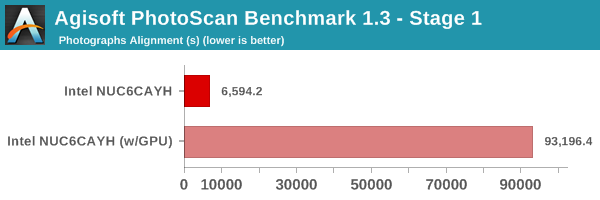
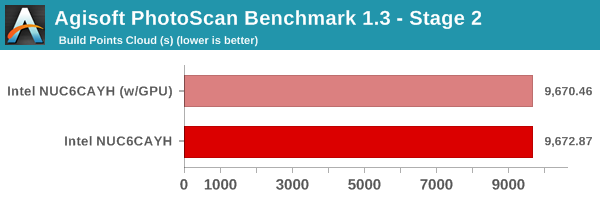
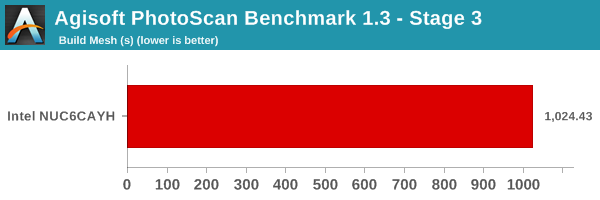
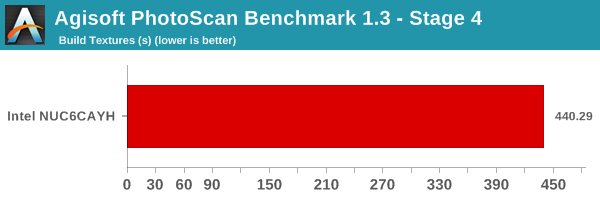
Dolphin Emulator
Wrapping up our application benchmark numbers is the new Dolphin Emulator (v5) benchmark mode results. This is again a test of the CPU capabilities, but, we do not have numbers with other systems to compare against.
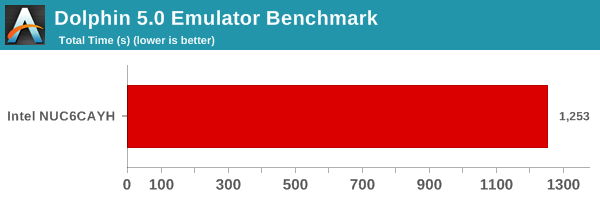










54 Comments
View All Comments
DSGT_Crockett - Thursday, January 18, 2018 - link
Interesting to me that one of the ~"usable" PCI-E lanes is 'taken up' by a Realtek NIC on an Intel ~AIO board ass'y. Realtek must really be giving those SOBs away for Intel not to have gone with their own branded NICs; but I realise as I type this that I may be playing the fool a couple ways, not least of which is a dire disconnection from mini/micro/whatever-computer equipment, and by no means do I mean to bang on your expert staff's doors with this ~obvious observation. Hell, it may have even been covered in the parts of the article I skimmed (:< I'm drunk, okay?) but I felt compelled to hit up the first page of the article with this because I'm used to Intel pushing their own network stuff _really_ hard. What gives?mode_13h - Saturday, January 20, 2018 - link
Yeah, it does seem weird, but does Intel even still make single-port Gig-E chips? It seems like their dedicated Ethernet silicon is probably focused on higher speeds & port-counts, while the low-end is probably integrated into their South Bridge chips (which this doesn't have, since it's an integrated SoC - mainly targeted at devices that lack Ethernet).Anyway, don't drunkpost. Go drink some coffee, tea, or go sleep it off.
sf101 - Monday, January 22, 2018 - link
wow this has a VGA out.That's surprising
Intel has really flip flopped on a standard Video output on these thats for sure.
sometimes HDMI sometimes only MINI - sometimes Displayport or only mini .. very surprised they added a VGA tbh.
Most wont understand this but upgrading a unit for older POS systems is a pain sometimes but adding a VGA adapter makes that far easier.
mode_13h - Friday, February 2, 2018 - link
For a lot of industrial and infrastructure applications, VGA is still in use. Not that this is exactly an industrial PC...